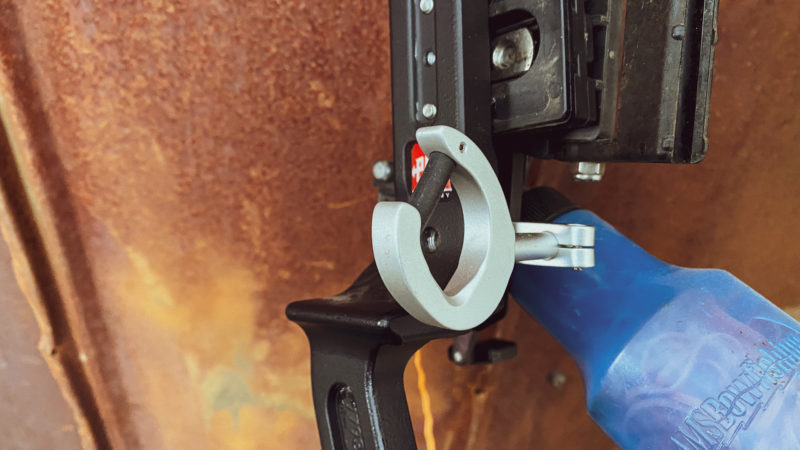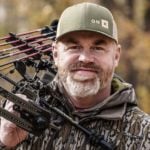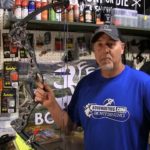The sport of bowfishing has experienced tremendous growth over the last decade with more shooters than ever hitting the water in search of fish with a bow in hand. And if you’re one of the many newcomers to the sport, we’ve prepared a list of the essentials you’ll need to get started.

The Bow
The beauty of bowfishing is that you can get started on a relatively tight budget. Most guys and gals start out with an old beater bow they’ve had hanging up in the shed, or picked up at pawn shop. If you can crank the poundage down light enough, old bows work great. You got to keep in mind, a bowfishing bow will be exposed to all kind of abuse, from mud, to water, and a constant beating as it’s bounced and banged around in the boat. There will be times when your bow is completely swamped or dropped in the water. So you really don’t want your best whitetail bowhunting rig out there on the water for bowfishing.

With that said, a number of companies now make bows designed specifically for bowfishing. They draw smoother, shoot faster, and are built with stainless steel components to handle the water. Most of these bows also enable you to snap-shoot at the fast and fleeting fish you typically encounter when bowfishing. Rarely will you have the time to draw, anchor, and slowly settle in on a target. Good bowfishing bows allow you to snap shoot at fish, whether at half-draw or when the string is at your cheek.
A heavy poundage bow is not necessary when it comes to bowfishing. A 30-pound bow is more than enough to do work on most species of fish. However some shooters prefer draw weights of 40+ pounds when it comes to punching larger fish and penetrating deeper water. Today’s top bows for bowfishing include the Oneida Osprey, Muzzy LV-X, Mission Hammr, AMS Hooligan, Cajun Sucker Punch, and PSE Tidal Wave.
The Bowfishing Reel
When it comes to bowfishing reels, you basically have two options, a bottle reel, or a spinner reel. With that said, there are some newer hybrid reel options on the market as well that have made an attempt at designing the best of both worlds into one reel.
A lot of folks start out with the bottle-style reel simply because it’s fool proof. There’s no buttons to push or drag to set. You simply draw and shoot. For some, the negative side of the bottle reel is having to set the bow down to retrieve fish hand over hand instead of being able to work the fish with the reel, as you can with a spinner. The spinner-style reel shines with smooth payout on the shot and lightning fast retrieval of your arrow. The spinner reel does require that you push a button or flip a switch to release the line for the shot.

Again, both reels have their advantages and disadvantages, and one may be a better option than the other depending on the day, type of water, and what style of bowfishing you’re trying to accomplish. Check out AMS Bowfishing and Cajun Bowfishing for the best in bottle-style reels. And when it comes to spinner reels, the crew at Muzzy seems to have it figured out. They build some of the beefiest bowfishing reels on the market.

Bowfishing Arrows & Points
Truth be told, the reel you use, as well as the arrows and points, tend to make more of a difference than the bow itself. Sure, a new, flashy bowfishing bow is nice, but you can can get by with old, used equipment when it comes to the bow. Where you don’t want to skimp is the reel or arrow setup.
Your arrows will take a ton of abuse. Buy the best you can afford. Encounters with big-scaled, chunky fish will put your arrows to the test. The splashing and thrashing your arrow will endure when it connects with a fish will no doubt confirm whether or not you got the right gear when it comes to arrows and points.

Fiberglass shafts continue to be the standard for bowfishing, while carbon arrows continue to gain in popularity, and even an aluminum jacketed fiberglass option from Easton has hit the store shelves in recent years. You can expect to pay about $12 for an entry level fiberglass bowfishing shaft and point. You can expect to see the price-tag double for Carbon arrow options.
Bowfishing points typically come in 2-barb and 3-barb models. 2-barb points fly great and are typically quicker to retrieve from the mud, weeds, and roots following a missed shot. 3-barb heads offer unbeatable holding power on big fish but can act like a grappling hook with underwater structure if you’re not careful.
Check out Muzzy, Innerloc, and AMS, for some of the leading fish points in the industry.
Best Arrow Rest for Bowfishing?
What about an arrow rest for bowfishing? Do you need one? Is it different from a regular hunting rest?
The bowfishing rest you use is often one of the most overlooked pieces of equipment on your setup. And it can easily be the most frustrating piece of equipment if you don’t get it right from the start. A lot of guys slap a plastic tab rest on their bowfishing bows and call it good, only to discover that it’s not enough for the heavier weight of a bowfishing arrow. The quick, fast-paced action of bowfishing demands that you use an arrow rest that keeps your arrow ready for the shot. You simply will not have time to place your arrow in the right spot prior to the shot.
One rest that stands at the top of the food chain when it comes to bowfishing rests is the Quick Draw Rest from Quick Draw Outdoor Gear. The Quick Draw rest ensures that your arrow is always ready for the shot, no matter whether you’re holding your bow upright, sideways, or upside down. Your arrow will be ready for the shot when you’re using the Quick Draw rest.

Polarized Sunglasses
When bowfishing during the day, polarized sunglasses are a must. These glasses will help you cut through the glare on the water and see fish below the surface. It’s truly amazing what you can see while wearing polarized glasses, compared to your inability to see fish without glasses. Don’t leave home without them!
The Costa Permit glasses are hard to beat when it comes to visibility while bowfishing, reducing eye strain, and protection from the sun.

Conclusion
Bowfishing provides the greatest bang for your buck when it comes to spring and summer shooting opportunities. It combines the best of archery, bowhunting, fishing, boating, and sometimes swimming. Grab the gear you need to get started, and make it happen this spring.

 By
By 



